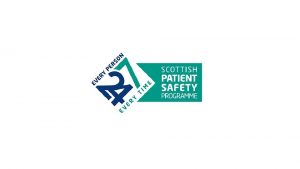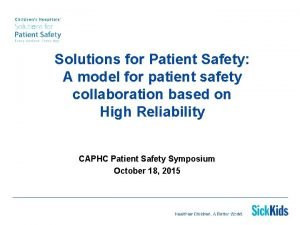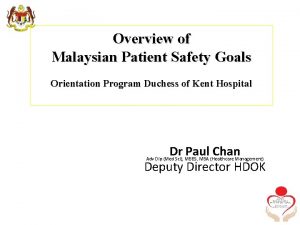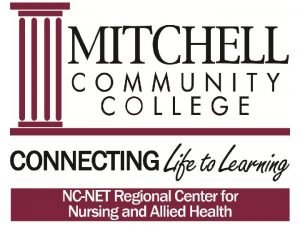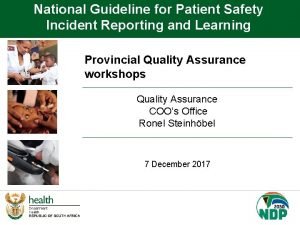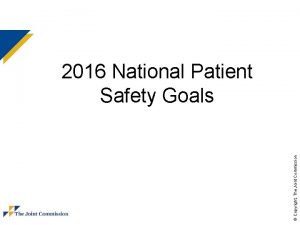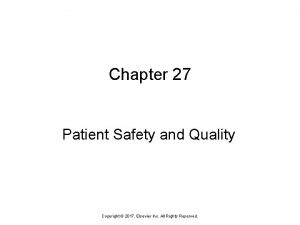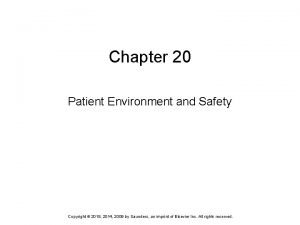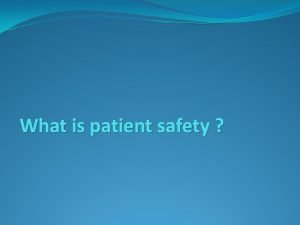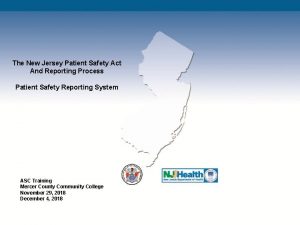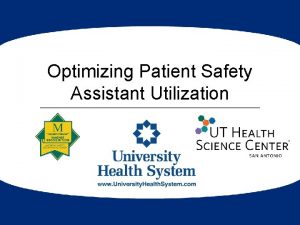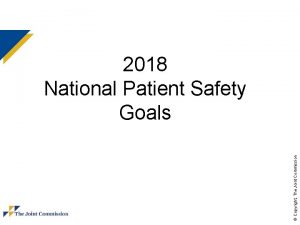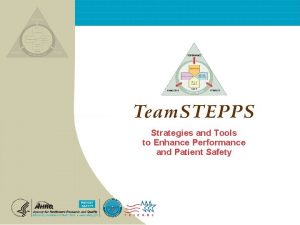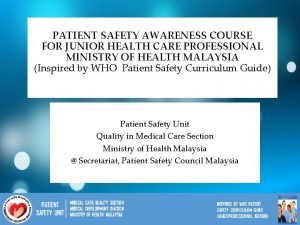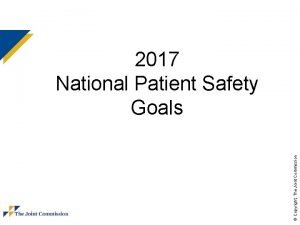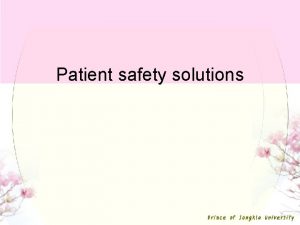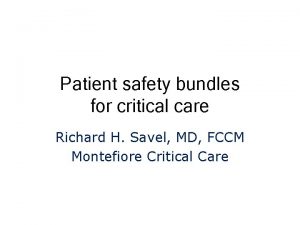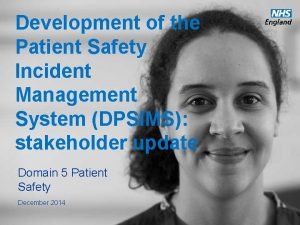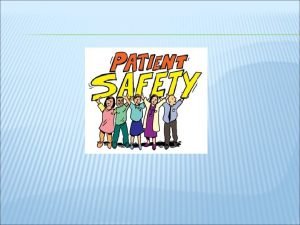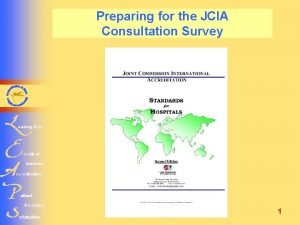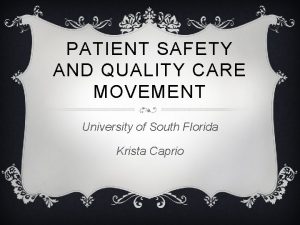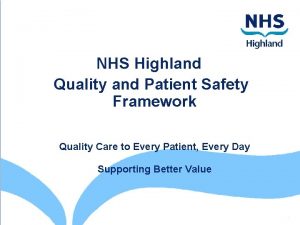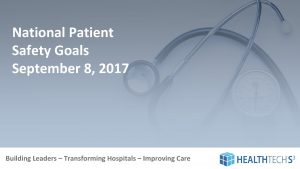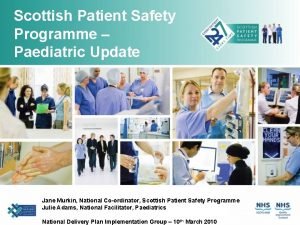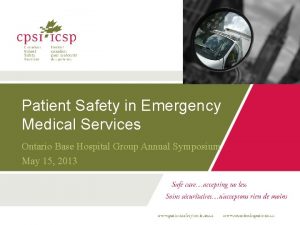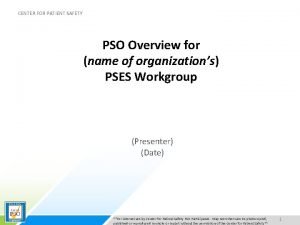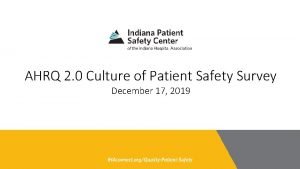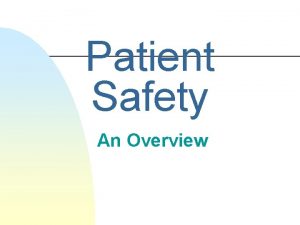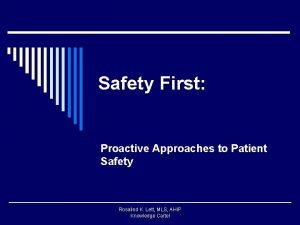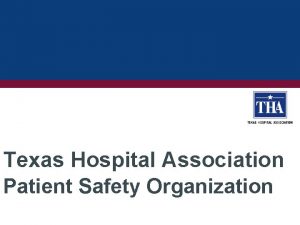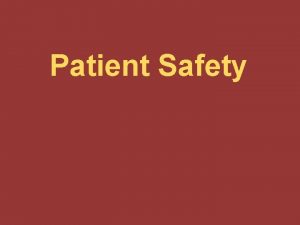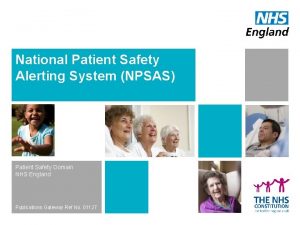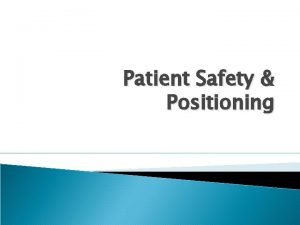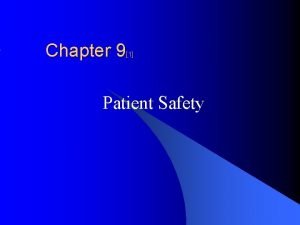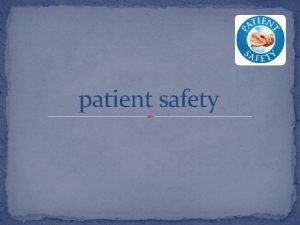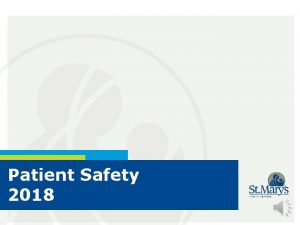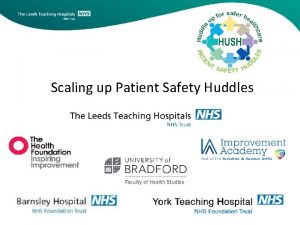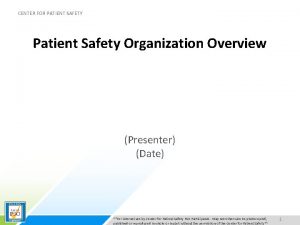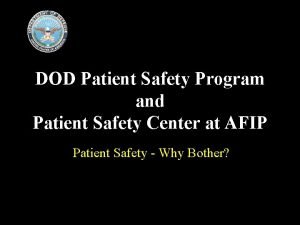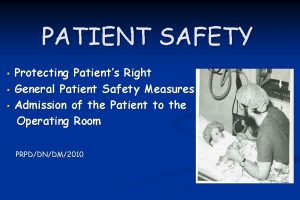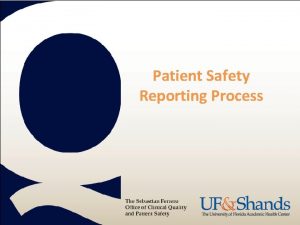1 Patient Safety Curriculum Practical Approaches to Patient





























- Slides: 29

1 Patient Safety Curriculum Practical Approaches to Patient Safety Module II Medication Safety, Systems & Communication

2 Patient Safety Curriculum Module II Practical Approaches to Patient Safety • Prescription and medication safety • Communication issues – tracking and follow-up – communication skills • Transcultural issues

3 Types of Medication Errors (>40 steps from doctor to patient) • Prescribing errors – wrong drug – wrong dose • Transcription errors (miscommunication) • Dispensing errors • Administration errors – – wrong drug wrong route wrong time improper syringe or IV prep

4 Common Causes of Medication Errors · Incomplete patient information · Unavailable drug information · Miscommunication of drug orders · Environmental factors and distractions · Labeling problems Source: AHA Quality Advisory 1999 http: //www. hospitalconnect. com/Desktop. Servlet

5 Common Causes of Medication Errors Incomplete Patient Information • Diagnoses • Lab values • Allergies Unavailable Drug Information • Drug contraindications • Other medications – Duplicate prescriptions – Drug interactions

6 Common Causes of Medication Errors Miscommunication of Drug Orders • Written prescriptions • Look-alike names • Sound-alike names • Misuse of decimal points and zeroes • Inappropriate abbreviations • Misuse of metric and apothecary measures • Ambiguous or incomplete orders

7 Common Causes of Medication Errors Environmental Factors and Distractions • Noise, interruptions – transcription errors – multitasking • Fatigue • Work overload • Poor lighting • Stocking and storage problems

8 Common Causes of Medication Errors Packaging and Labeling Problems Look-alike packaging Hard-to-read labels Source: Institute for Safe Medication Practices 2000. (Photos used with permission)

9 Common Causes of Medication Errors When the Patient Leaves the Office • Dispensing error at pharmacy • Failure to read or understand labeling and product information • Drug (e. g. , OTCs) or food interactions • Non-adherence – Prescription not filled or refilled – wrong dose, wrong time – improper administration (e. g. , asthma inhalers)

10 Solutions for Look-alike or Sound-alike Names • Don’t rely solely on memory • Tips for error prevention – tell the patient/caregiver what it is and why you are prescribing it – provide both generic and brand names on handwritten prescriptions – consider e. Pocrates, MDPad, i. Scribe for Palm Pilot – Computerized Physician Order Entry (CPOE) systems Source: Cohen M. Medication Errors 1999. Joint Commission on Accreditation of Healthcare Organizations 2001; National Coordinating Council for Medication Errors Reporting and Prevention 2001.

11 Solutions for Look-alike or Sound-alike Names For Verbal or Telephone Orders • Spell out the name of the drug – E. g. , “X” and “Z” are common sound-alikes • Ask listener to repeat the drug name, dosage, and frequency —“Hear Back” Source: National Coordinating Council for Medication Error Reporting and Prevention 2001.

12 Danger of Handwritten Prescriptions • Virtually all prescriptions are handwritten • >30% of pharmacies investigated (n = 245) filled prescriptions for potentially lethal drug combinations • Computerized pharmacy orders increase safety – allergy alerts – interaction alerts – tracking and record-keeping functions Source: Schiff GD, Rucker TD. Computerized Prescribing, JAMA, 1998. Cavuto NJ, et al. Pharmacies and prevention of potentially fatal drug interactions, JAMA, 1996.

13 Solutions for Measures and Administration Orders • Symbols and abbreviations can be dangerous – Q. D. Q. I. D. Q. O. D. – Never use “U” for “unit, ” easily confused with “ 0” and “ 4” – Write the indication with “prn” meds • Triple check dose, form (e. g. , XL, CR, SR), and frequency • Use leading zeroes, but not trailing zeroes – 0. 5 NOT. 5 – 5 NOT 5. 0 • If you must write, do so legibly! Source: Cohen M. Medication Errors 1999.

14 Group Discussion • What do you see in your practice? • How do you deal with it? – What or who helps? (maximize) – What or who hinders? (remedy or removal)

15 Medication Errors at Home • Patients or caregivers are in control • Pharmacists are your partners • Information and education are critical – is labeling/information easy to read? – is labeling/information easy to understand? – how do you know?

16 Systems & Communication Tracking and Follow-Up What happens when… • you hand off to another physician? • the patient goes home? • the patient switches health plans? • the patient moves to a different state? How do you know?

17 Systems & Communication Dealing with Handoffs Handoff = Opportunity for Error • Miscommunication – – especially with verbal communications listening skills are critical: “Hear Back”! due to distractions (e. g. , noise, interruptions) due to fatigue and stress

18 Systems & Communication Tracking and Follow-Up Reducing the Risk of Error • information must follow the patient

19 Systems & Communication Continuity of Care and Safety High Risk • Chronic conditions – complex care – many providers • • Changing health plans/employers Vulnerable populations Cultural/language issues Post-screening – for cancer, cardiovascular disease, etc.

20 Systems & Communication Electronic Medical Records • Tremendous potential – rapid, seamless communication; easy retrieval – automatic interaction and allergy checking • Barriers to adoption – patient privacy – money – reimbursement – training – proprietary systems that can’t communicate with each other

22 Systems & Communication Skills • Sometimes we see or hear what we expect, not what’s really there – slips and lapses due to conditioning biases • Every link in a chain of communications harbors a latent failure – put it in writing

23 Systems & Communication Skills Many Ways to Communicate • Speaking – face-to-face – via telephone • Writing – on a chart, sign-out, or prescription pad – in a letter or fax – via computer (e-mail) • Sign language • Body language

24 Systems & Communication Transcultural Issues Cultural Diversity Adds Complexity • Language barriers: “once” vs. once • Health belief models • Social styles and moral values • Religious beliefs and practices • Economic considerations

25 Systems & Communication Language Barriers • Access to translators – “language banks”: AT&T, etc. – multicultural staff – judicious use of family members as translators • Qualifications – ability to translate medical terminology – competence with dialects • Expense/reimbursement – another unfunded mandate – an issue that will not go away

26 Systems & Communication Health Belief Models • Diverse views on health and wellness – perceptions of distinguishing physical attributes – how the human body works and stays well • Attitudes toward physical intervention – drawing or receiving blood; surgery – laying on of hands • “Alternative” therapies – home remedies – physical therapies (e. g. , acupuncture) – diet

27 Systems & Communication Social Styles and Moral Values • Trust • Eye contact – propriety • Touch – modesty • Social interactions – within family systems – between males and females – between different age groups

28 Systems & Communication Religious Belief and Practices • Fasting • Prayer • Reverence for elders, family, and ancestors

30 Systems & Communication Transcultural Issues Group Discussion • What do you see and hear in your practice? • How do you deal with it? – What or who helps? (maximize) – What or who hinders? (remedy or removal)

31 Module II - Conclusion • Prescription and medication safety – look-alike and sound-alike drug names – decimals, zeroes, and abbreviations – CPOE and pharmacist consults can reduce errors • Tracking and follow-up – chronic conditions present problems – complete, accurate charting and confirmation – electronic medical record systems can help • Transcultural issues – more than language
 Patient 2 patient
Patient 2 patient Scottish patient safety programme
Scottish patient safety programme Solutions for patient safety bundles
Solutions for patient safety bundles Patient safety malaysia
Patient safety malaysia National patient safety goals 2012
National patient safety goals 2012 National guideline for patient safety incident
National guideline for patient safety incident To err is human to cover up is unforgivable
To err is human to cover up is unforgivable The national patient safety goal 6
The national patient safety goal 6 Chapter 27 patient safety and quality
Chapter 27 patient safety and quality Chapter 20 patient environment and safety
Chapter 20 patient environment and safety History of patient safety
History of patient safety Nj patient safety act
Nj patient safety act Patient sitter algorithm
Patient sitter algorithm Dod patient safety program
Dod patient safety program 2018 national patient safety goals
2018 national patient safety goals Sue sheridan patient safety
Sue sheridan patient safety Patient safety goals - awareness course
Patient safety goals - awareness course National patient safety goals 2017
National patient safety goals 2017 Patient safe solutions
Patient safe solutions Ihi care bundles
Ihi care bundles Patient safety incident management system
Patient safety incident management system 2013 hospital national patient safety goals
2013 hospital national patient safety goals Patient safety goals
Patient safety goals Patient safety and quality care movement
Patient safety and quality care movement National patient safety framework
National patient safety framework National safety goal 6
National safety goal 6 Jane murkin
Jane murkin Canadian patient safety officer course
Canadian patient safety officer course Patient safety evaluation system
Patient safety evaluation system Ahrq patient safety survey
Ahrq patient safety survey

